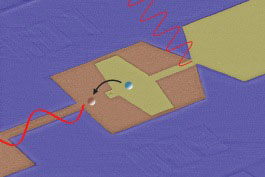| Posted: February 2, 2009 |
Nanotechnology significantly increases the sensitivity of new supertelescopes |
|
(Nanowerk News) Nanotechnologist Chris Lodewijk has succeeded in significantly increasing the sensitivity of the new supertelescopes in Chile. He will receive his PhD on this topic at Delft University of Technology on Monday 2 February.
|
|
In Chile's Atacama desert, technicians and astronomers from around the world are currently working on the Atacama Large Millimeter Array (ALMA). This consists of 66 advanced telescopes which will be placed at an altitude of 5,000 metres and together will provide a more precise image of the universe. They are chiefly aimed at shedding light on the question of how stars and planets are formed. ALMA is expected to be taken into service in 2012 and is viewed by astronomers as a major step forward for their field.
|
|
Aluminium nitride
|
|
Dutch astronomers have been closely involved in developing ALMA in a fruitful collaboration with nanotechnologists. The latest contribution from the nano-world comes from PhD candidate Chris Lodewijk and technician Tony Zijlstra at Delft University of Technology's Kavli Institute of Nanoscience. They have succeeded in drastically increasing the sensitivity of ALMA in a crucial frequency range by improving the functioning of the major component, the radiation-sensor.
|
 |
|
This involves what are known as super-conducting tunnel junctions. These miniscule sensors comprise two superconductors which are separated by an insulating layer measuring 1 to 2 nanometres, usually of aluminium oxide, with an area of 500 by 500 nanometres.
|
|
However, it is impossible to avoid a very thin layer of 1 nanometre of aluminium oxide 'leaking' in certain spots. Lodewijk and Zijlstra therefore conducted research into replacing aluminium oxide with aluminium nitride (AlN), with spectacular results. An aluminium nitride layer proves to be much more homogeneous and its sensitivity, in the 602 to 720 GHz range, is also much improved.
|
|
Herschel
|
|
Incidentally, Lodewijk's research topic of super-conducting tunnel junctions is also essential to the functioning of the Herschel Space Telescope, which is to be launched in April. The Herschel Space Telescope is the successor to the Hubble telescope. Delft University of Technology's Kavli Institute of Nanoscience has developed many of the crucial tunnel junctions for the Herschel Telescope's measuring equipment.
|

